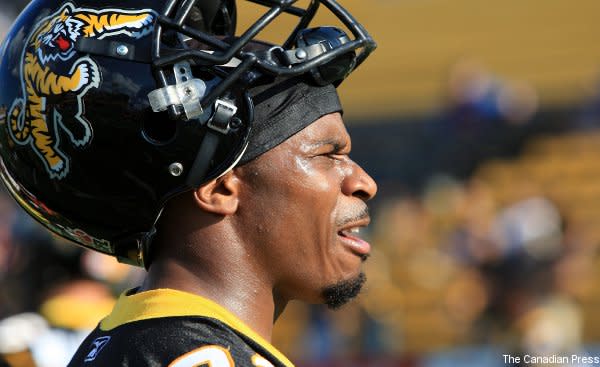The Tiger-Cats release Avon Cobourne again, suggesting the CFL still dislikes older RBs
It's unusual when the release of a team's top rusher from the previous season seems unsurprising, but the specific circumstances around the Hamilton Tiger-Cats' decision to cut Avon Cobourne Saturday make this an expected move. Yes, Cobourne had a solid year in Hamilton, collecting a team-high 737 rushing yards on 124 carries (for a 5.9 yards-per-carry average, miles better than the 4.8 he averaged in 2011) and adding 32 catches for 337 yards, but he never seemed like a fit with the Tiger-Cats going forward. Cobourne wasn't even expected to be with the team last season, and was actually cut and working in insurance in Florida before Hamilton brought him back following Martell Mallett's season-ending Achilles tendon tear in practice. With Mallett healthy again and the emergence of rookie Chevon Walker, the Tiger-Cats have plenty of options at running back, and Cobourne was the odd man out.
Does this spell the end of Cobourne's CFL career? Quite possibly. That's odd from one perspective, as he proved in 2012 that he can still be a very capable player in this league, but when you consider some other factors, it makes some sense. Most importantly, Cobourne will be 34 in March, and the CFL has a long history of getting rid of older running backs. Running back is seen as a position with an early expiry date, and whether that's completely fair or not (the performances of older guys like Cobourne when given a chance would suggest it's not the whole story), that philosophy governs how most CFL teams behave. Thus, regardless of if Cobourne can still play (and the numbers from last year would suggest he can), most CFL teams aren't going to regard him highly just based on his age.
It's not just about age, either. Simple supply and demand makes running back perhaps the most difficult position for a player to land a good CFL contract at. First, the CFL's passing emphasis means that the running game is generally a team's second priority. Teams do still want to run the ball, but there usually aren't a ton of carries to go around, so that combines with the limitations of the CFL salary cap to mean that a given team will only typically invest heavily in one running back. (We have seen teams try dual-running back arrangements before, but not with a huge amount of success: Hamilton somewhat did this with Cobourne and Walker last year, but they also often started one and scratched the other, and the Joffrey Reynolds/Jon Cornish carry-sharing agreement in Calgary a few years back didn't last too long.) That means there are essentially eight good running back jobs in the CFL right now, and that's why there aren't even a lot of great landing spots for a RB as good and as young (27) as Montreal free agent Brandon Whitaker, the CFL's 2011 rushing leader. While Whitaker can obviously play, he's coming off surgery and most teams already have the running back they want to start. When even Whitaker's future as a CFL starter is in question, it's tough to see the seven-years-older Cobourne finding another starting gig in this league.
What about backup roles? Well, it's certainly possible Cobourne could get one of those, but here's where another element of supply and demand kicks in. Simply, there are far more good running backs out there than there are jobs. There are 120 schools competing in the NCAA's top division (Division I FBS), and all of those schools tend to have at least one capable running back, often more given the greater emphasis on running in the American game. That's to say nothing of lower divisions: Division I FCS, Division II, Division III and even the NAIA have produced plenty of talent over the years too. Not all of those RBs graduate every year, of course, but there's always a huge flood of running backs coming out of American schools, and only a few of them get snapped up by the NFL. When you throw in the rise of the Canadian running back (which has CFL teams seriously considering top runners from the CIS and CJFL ranks as well) and the NFL's cuts, there are huge numbers of young, talented and hungry running backs looking for a chance (and willing to take a low contract), and the CFL's teams usually have more than enough prospects to choose from.
Moreover, running back isn't like receiver or defensive back, where you have a lot of players on the field at once and have plenty of places where you can rotate players to get them some snaps. There's almost always just one tailback in CFL offensive formations (there's sometimes a fullback as well, but that tends to be a separate pool of players), and that tailback isn't often rotated out. Add all of those factors up, and it's tough to see another CFL team bringing in Cobourne even as a backup (especially if you also consider that he's found a good off-field job before, so he may not want to keep playing for minimal money). That's somewhat unfortunate, as he's had a remarkable CFL career in Montreal and Hamilton and he proved last season that he can still play, but it's just the reality of how older running backs are viewed in this league.

 Yahoo Sports
Yahoo Sports 


